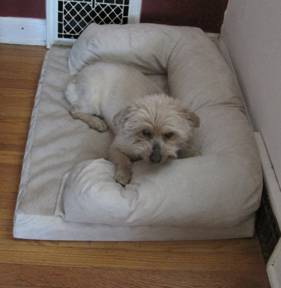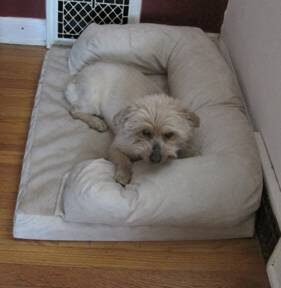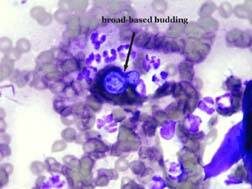Cognitive Dysfunction Syndrome in Dogs
What is Cognitive Dysfunction Syndrome?
Cognitive dysfunction syndrome (CDS) is essentially the dog equivalent of Alzheimer’s disease. With CDS, a dog’s brain gradually degenerates, leading to abnormal and senile behaviors that reflect declining cognitive function. CDS is common in older dogs, generally occurring after 9 years of age.
CDS is caused by age-related changes to the brain. In dogs with CDS, a substance toxic to the brain called “beta-amyloid protein” accumulates. Other changes in the brain include reduced blood flow and dysfunctional neurons. Neurons are the cells that carry information throughout the brain and body. When neurons don’t function correctly, the brain’s ability to remember, process information and tell the body what to do is impaired.

What are the Signs?
The acronym “DISHAAL” can be used to describe the signs of CDS. It stands for: Disorientation, Abnormal Interactions, Sleep/wake cycle disturbances, House soiling, Activity changes, Anxiety and Learning/memory changes.
Signs of CDS an owner may recognize include:
- Wandering
- Anxiety
- Confusion
- Urinating/defecating in the house
- Pacing, often at night
- Less interaction with owners
- Not recognizing familiar people, animals or commands
- Less interest in eating, playing, walking and socializing
- Restlessness
- Waking up in the night; increased daytime sleeping
- Inactivity
- Increased vocalization, often at night
- Going to unusual places
- Can’t locate food dropped on the floor
- Getting lost in familiar environment
How is it Diagnosed?
To diagnose CDS, a veterinarian will rely on information given by the owner, the dog’s symptoms and physical exam findings. To rule out other causes of the dog’s symptoms, the veterinarian may use additional tools such as blood and urine tests. An MRI may be done to look for abnormalities in the dog’s brain.
How is CDS Treated?
There is no cure for canine CDS. However, there are a number of treatments that may slow progression of the disease and relieve some of the dog’s symptoms.
Treatments for CDS include:
Dietary changes: Your dog may be put on a specific therapeutic diet designed to help. These diets contain ingredients such as antioxidants, fats and fatty acids that may protect and promote healthy brain cells.
Dietary supplements: Your veterinarian may recommend dietary supplements such as Senilife®, which is rich in antioxidants, or oils rich in a type of fat called “medium-chain triglycerides.” Medium-chain triglycerides provide energy to the dog’s brain, which is helpful because the brain is less able to use glucose for energy in CDS.
Drugs: Your veterinarian may recommend medications that could improve your dog’s cognitive function. These include MAO inhibitors such as Anipryl, which may help neurons communicate with each other and protect the brain from damage. Drugs such as propentofylline, which is licensed for use in some countries in Europe, increase blood flow in the brain and may help dogs with CDS.
Cognitive enrichment: Cognitive enrichment may improve your dog’s brain function. Cognitive enrichment consists of exercise, social interactions, providing new toys and teaching new commands to your dog.
Some veterinarians may suggest trying herbal therapies and acupuncture. These methods have the potential to help affected dogs, but they have not been well-studied in dogs with CDS.
What is the Prognosis for CDS?
There is no cure for canine CDS, so the disease will progress. However, if CDS is caught early and treated effectively, the dog could live a full, quality lifespan. Unfortunately, dogs with severe cases of CDS generally have a worse outcome, often being euthanized about 2 years after signs of CDS appear.
If you notice signs of CDS in your dog, it’s best not to just attribute them to old age; see your veterinarian.














